Equality and Diversity Impact on Gender Pay Gap: Sollatek Case
VerifiedAdded on 2023/01/13
|24
|5025
|50
Report
AI Summary
This report investigates the significance of equality and diversity in the workplace, specifically focusing on its role in mitigating the gender pay gap, using Sollatek as a case study. The research encompasses a project management plan, including aims, objectives, work breakdown structure, and a Gantt chart. The study employs both qualitative and quantitative research methods, including questionnaires administered to employees. The data analysis involves various tools and techniques to identify existing policies and strategies. The report provides recommendations based on the research findings and data analysis, exploring the benefits of incorporating equality and diversity. The report also includes a reflection on the value of undertaking the research, providing a comprehensive overview of the issue and potential solutions for Sollatek to address the gender pay gap and promote a more equitable workplace.

Managing a Successful
Business Project
Business Project
Paraphrase This Document
Need a fresh take? Get an instant paraphrase of this document with our AI Paraphraser
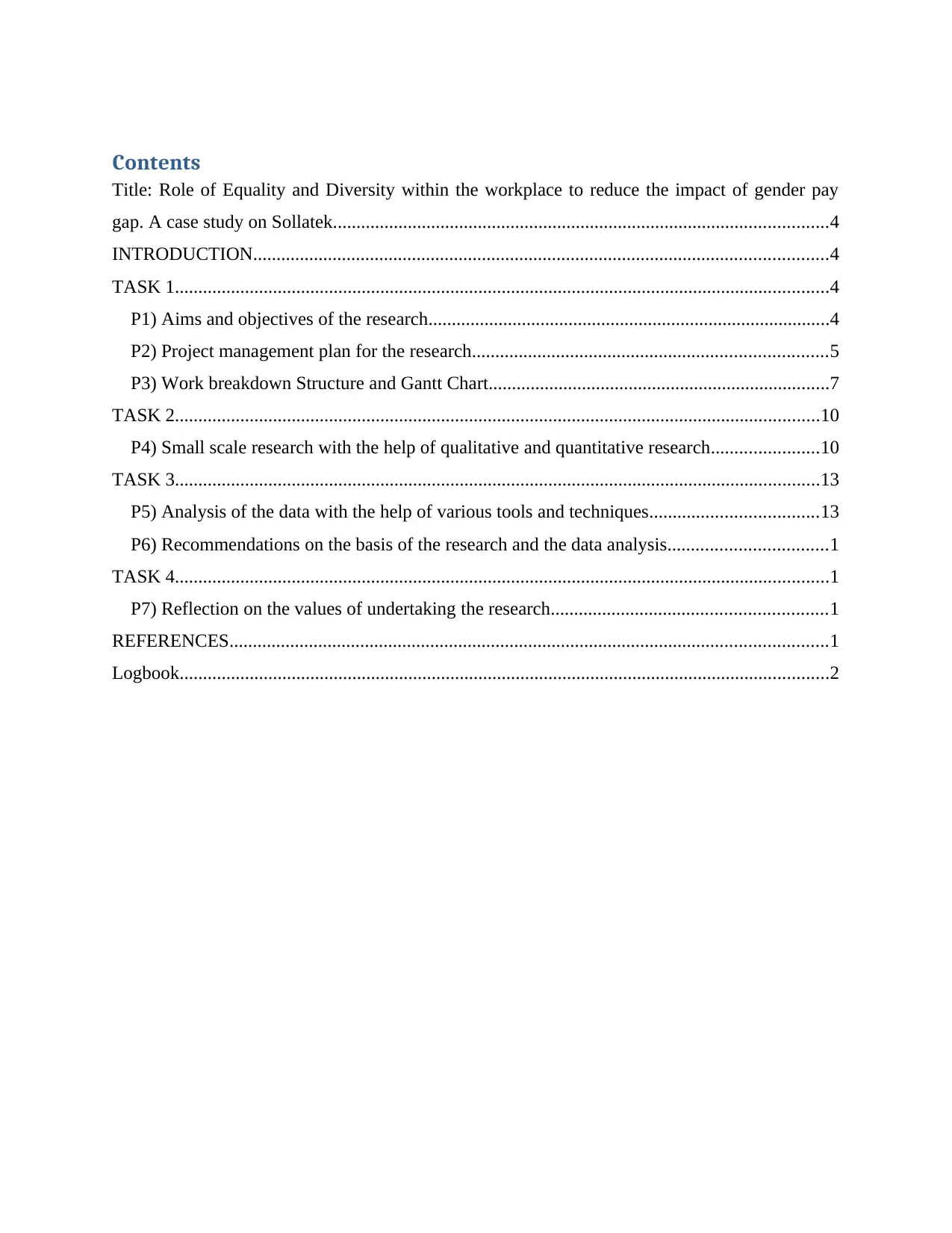
Contents
Title: Role of Equality and Diversity within the workplace to reduce the impact of gender pay
gap. A case study on Sollatek..........................................................................................................4
INTRODUCTION...........................................................................................................................4
TASK 1............................................................................................................................................4
P1) Aims and objectives of the research......................................................................................4
P2) Project management plan for the research............................................................................5
P3) Work breakdown Structure and Gantt Chart.........................................................................7
TASK 2..........................................................................................................................................10
P4) Small scale research with the help of qualitative and quantitative research.......................10
TASK 3..........................................................................................................................................13
P5) Analysis of the data with the help of various tools and techniques....................................13
P6) Recommendations on the basis of the research and the data analysis..................................1
TASK 4............................................................................................................................................1
P7) Reflection on the values of undertaking the research...........................................................1
REFERENCES................................................................................................................................1
Logbook...........................................................................................................................................2
Title: Role of Equality and Diversity within the workplace to reduce the impact of gender pay
gap. A case study on Sollatek..........................................................................................................4
INTRODUCTION...........................................................................................................................4
TASK 1............................................................................................................................................4
P1) Aims and objectives of the research......................................................................................4
P2) Project management plan for the research............................................................................5
P3) Work breakdown Structure and Gantt Chart.........................................................................7
TASK 2..........................................................................................................................................10
P4) Small scale research with the help of qualitative and quantitative research.......................10
TASK 3..........................................................................................................................................13
P5) Analysis of the data with the help of various tools and techniques....................................13
P6) Recommendations on the basis of the research and the data analysis..................................1
TASK 4............................................................................................................................................1
P7) Reflection on the values of undertaking the research...........................................................1
REFERENCES................................................................................................................................1
Logbook...........................................................................................................................................2

⊘ This is a preview!⊘
Do you want full access?
Subscribe today to unlock all pages.

Trusted by 1+ million students worldwide
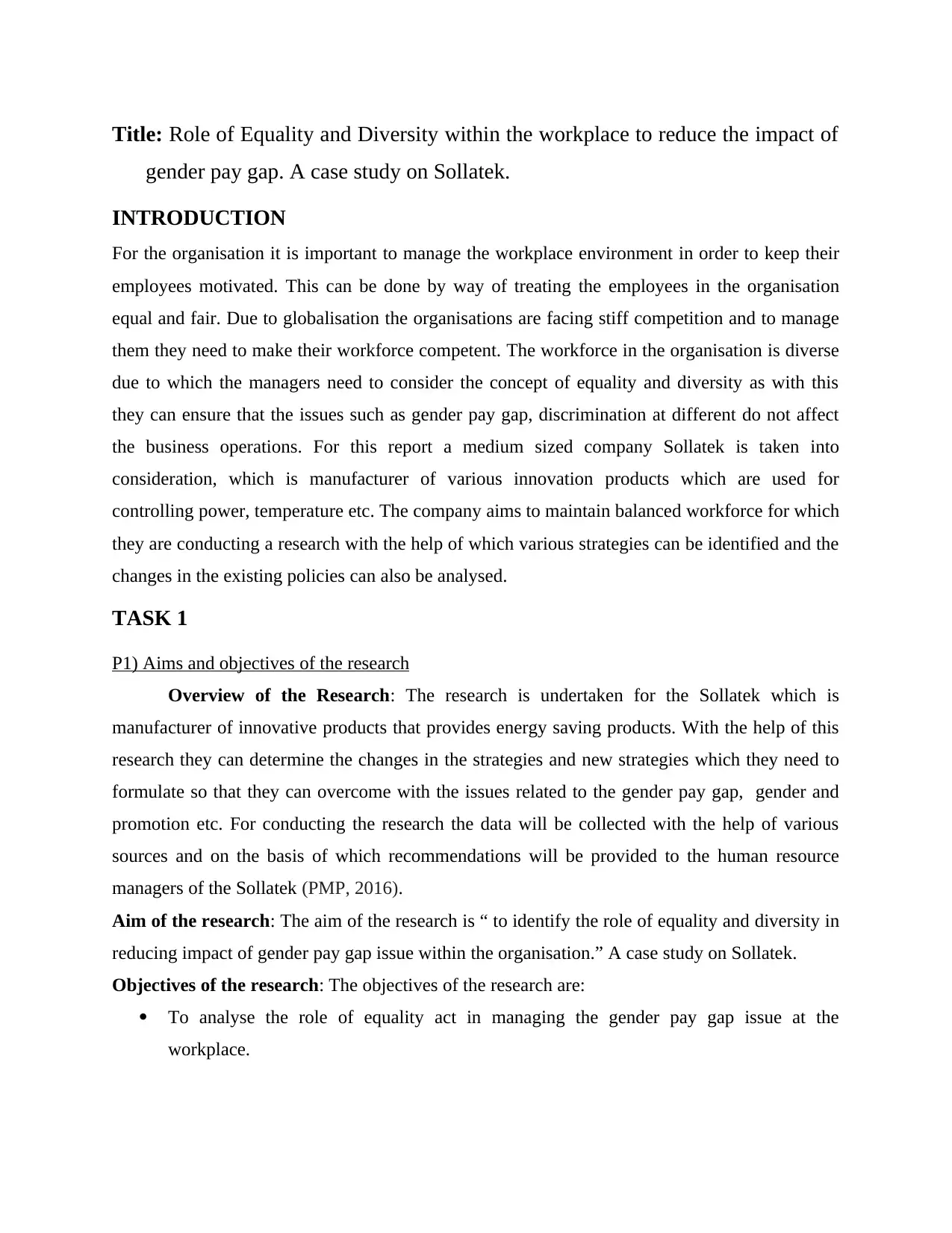
Title: Role of Equality and Diversity within the workplace to reduce the impact of
gender pay gap. A case study on Sollatek.
INTRODUCTION
For the organisation it is important to manage the workplace environment in order to keep their
employees motivated. This can be done by way of treating the employees in the organisation
equal and fair. Due to globalisation the organisations are facing stiff competition and to manage
them they need to make their workforce competent. The workforce in the organisation is diverse
due to which the managers need to consider the concept of equality and diversity as with this
they can ensure that the issues such as gender pay gap, discrimination at different do not affect
the business operations. For this report a medium sized company Sollatek is taken into
consideration, which is manufacturer of various innovation products which are used for
controlling power, temperature etc. The company aims to maintain balanced workforce for which
they are conducting a research with the help of which various strategies can be identified and the
changes in the existing policies can also be analysed.
TASK 1
P1) Aims and objectives of the research
Overview of the Research: The research is undertaken for the Sollatek which is
manufacturer of innovative products that provides energy saving products. With the help of this
research they can determine the changes in the strategies and new strategies which they need to
formulate so that they can overcome with the issues related to the gender pay gap, gender and
promotion etc. For conducting the research the data will be collected with the help of various
sources and on the basis of which recommendations will be provided to the human resource
managers of the Sollatek (PMP, 2016).
Aim of the research: The aim of the research is “ to identify the role of equality and diversity in
reducing impact of gender pay gap issue within the organisation.” A case study on Sollatek.
Objectives of the research: The objectives of the research are:
To analyse the role of equality act in managing the gender pay gap issue at the
workplace.
gender pay gap. A case study on Sollatek.
INTRODUCTION
For the organisation it is important to manage the workplace environment in order to keep their
employees motivated. This can be done by way of treating the employees in the organisation
equal and fair. Due to globalisation the organisations are facing stiff competition and to manage
them they need to make their workforce competent. The workforce in the organisation is diverse
due to which the managers need to consider the concept of equality and diversity as with this
they can ensure that the issues such as gender pay gap, discrimination at different do not affect
the business operations. For this report a medium sized company Sollatek is taken into
consideration, which is manufacturer of various innovation products which are used for
controlling power, temperature etc. The company aims to maintain balanced workforce for which
they are conducting a research with the help of which various strategies can be identified and the
changes in the existing policies can also be analysed.
TASK 1
P1) Aims and objectives of the research
Overview of the Research: The research is undertaken for the Sollatek which is
manufacturer of innovative products that provides energy saving products. With the help of this
research they can determine the changes in the strategies and new strategies which they need to
formulate so that they can overcome with the issues related to the gender pay gap, gender and
promotion etc. For conducting the research the data will be collected with the help of various
sources and on the basis of which recommendations will be provided to the human resource
managers of the Sollatek (PMP, 2016).
Aim of the research: The aim of the research is “ to identify the role of equality and diversity in
reducing impact of gender pay gap issue within the organisation.” A case study on Sollatek.
Objectives of the research: The objectives of the research are:
To analyse the role of equality act in managing the gender pay gap issue at the
workplace.
Paraphrase This Document
Need a fresh take? Get an instant paraphrase of this document with our AI Paraphraser
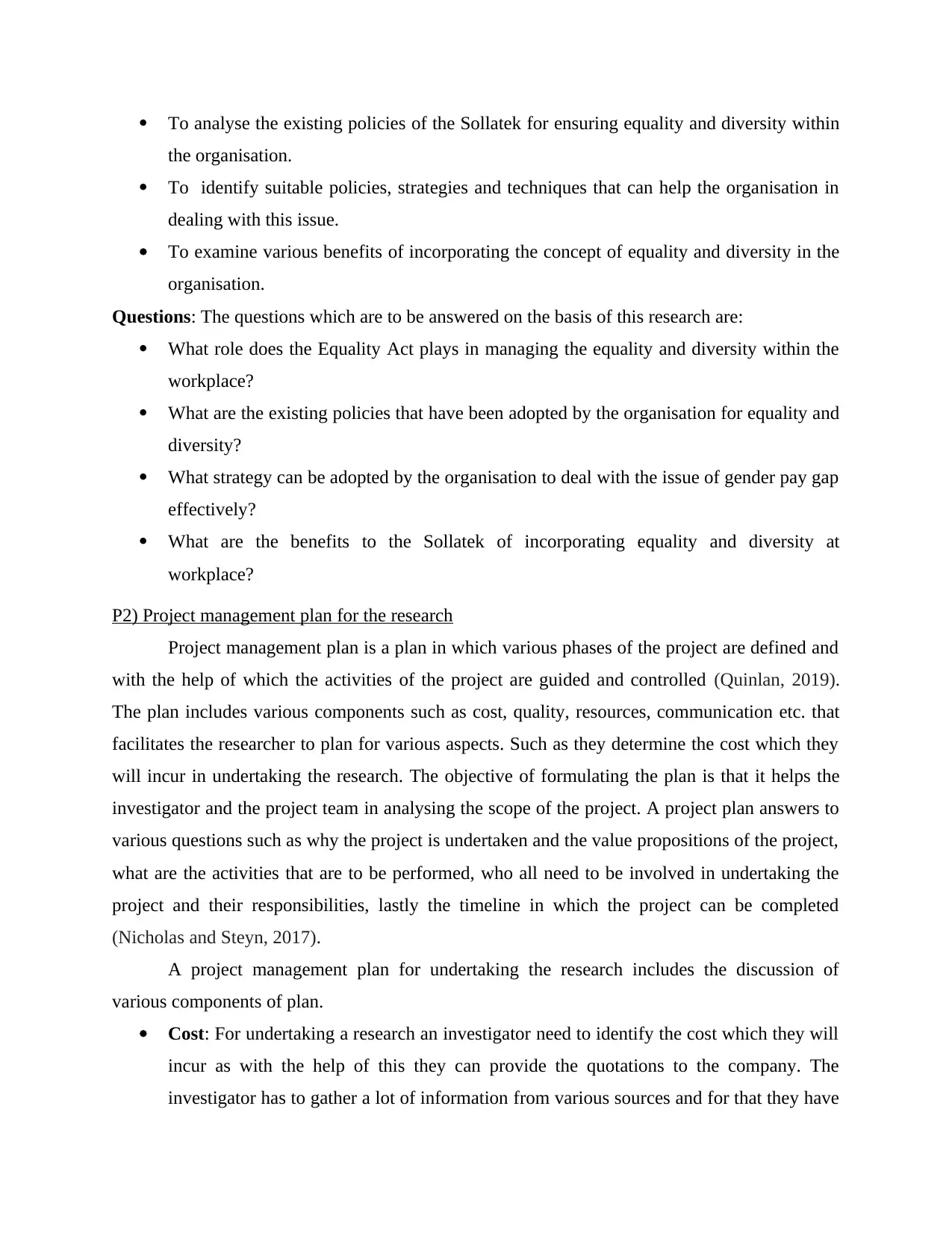
To analyse the existing policies of the Sollatek for ensuring equality and diversity within
the organisation.
To identify suitable policies, strategies and techniques that can help the organisation in
dealing with this issue.
To examine various benefits of incorporating the concept of equality and diversity in the
organisation.
Questions: The questions which are to be answered on the basis of this research are:
What role does the Equality Act plays in managing the equality and diversity within the
workplace?
What are the existing policies that have been adopted by the organisation for equality and
diversity?
What strategy can be adopted by the organisation to deal with the issue of gender pay gap
effectively?
What are the benefits to the Sollatek of incorporating equality and diversity at
workplace?
P2) Project management plan for the research
Project management plan is a plan in which various phases of the project are defined and
with the help of which the activities of the project are guided and controlled (Quinlan, 2019).
The plan includes various components such as cost, quality, resources, communication etc. that
facilitates the researcher to plan for various aspects. Such as they determine the cost which they
will incur in undertaking the research. The objective of formulating the plan is that it helps the
investigator and the project team in analysing the scope of the project. A project plan answers to
various questions such as why the project is undertaken and the value propositions of the project,
what are the activities that are to be performed, who all need to be involved in undertaking the
project and their responsibilities, lastly the timeline in which the project can be completed
(Nicholas and Steyn, 2017).
A project management plan for undertaking the research includes the discussion of
various components of plan.
Cost: For undertaking a research an investigator need to identify the cost which they will
incur as with the help of this they can provide the quotations to the company. The
investigator has to gather a lot of information from various sources and for that they have
the organisation.
To identify suitable policies, strategies and techniques that can help the organisation in
dealing with this issue.
To examine various benefits of incorporating the concept of equality and diversity in the
organisation.
Questions: The questions which are to be answered on the basis of this research are:
What role does the Equality Act plays in managing the equality and diversity within the
workplace?
What are the existing policies that have been adopted by the organisation for equality and
diversity?
What strategy can be adopted by the organisation to deal with the issue of gender pay gap
effectively?
What are the benefits to the Sollatek of incorporating equality and diversity at
workplace?
P2) Project management plan for the research
Project management plan is a plan in which various phases of the project are defined and
with the help of which the activities of the project are guided and controlled (Quinlan, 2019).
The plan includes various components such as cost, quality, resources, communication etc. that
facilitates the researcher to plan for various aspects. Such as they determine the cost which they
will incur in undertaking the research. The objective of formulating the plan is that it helps the
investigator and the project team in analysing the scope of the project. A project plan answers to
various questions such as why the project is undertaken and the value propositions of the project,
what are the activities that are to be performed, who all need to be involved in undertaking the
project and their responsibilities, lastly the timeline in which the project can be completed
(Nicholas and Steyn, 2017).
A project management plan for undertaking the research includes the discussion of
various components of plan.
Cost: For undertaking a research an investigator need to identify the cost which they will
incur as with the help of this they can provide the quotations to the company. The
investigator has to gather a lot of information from various sources and for that they have
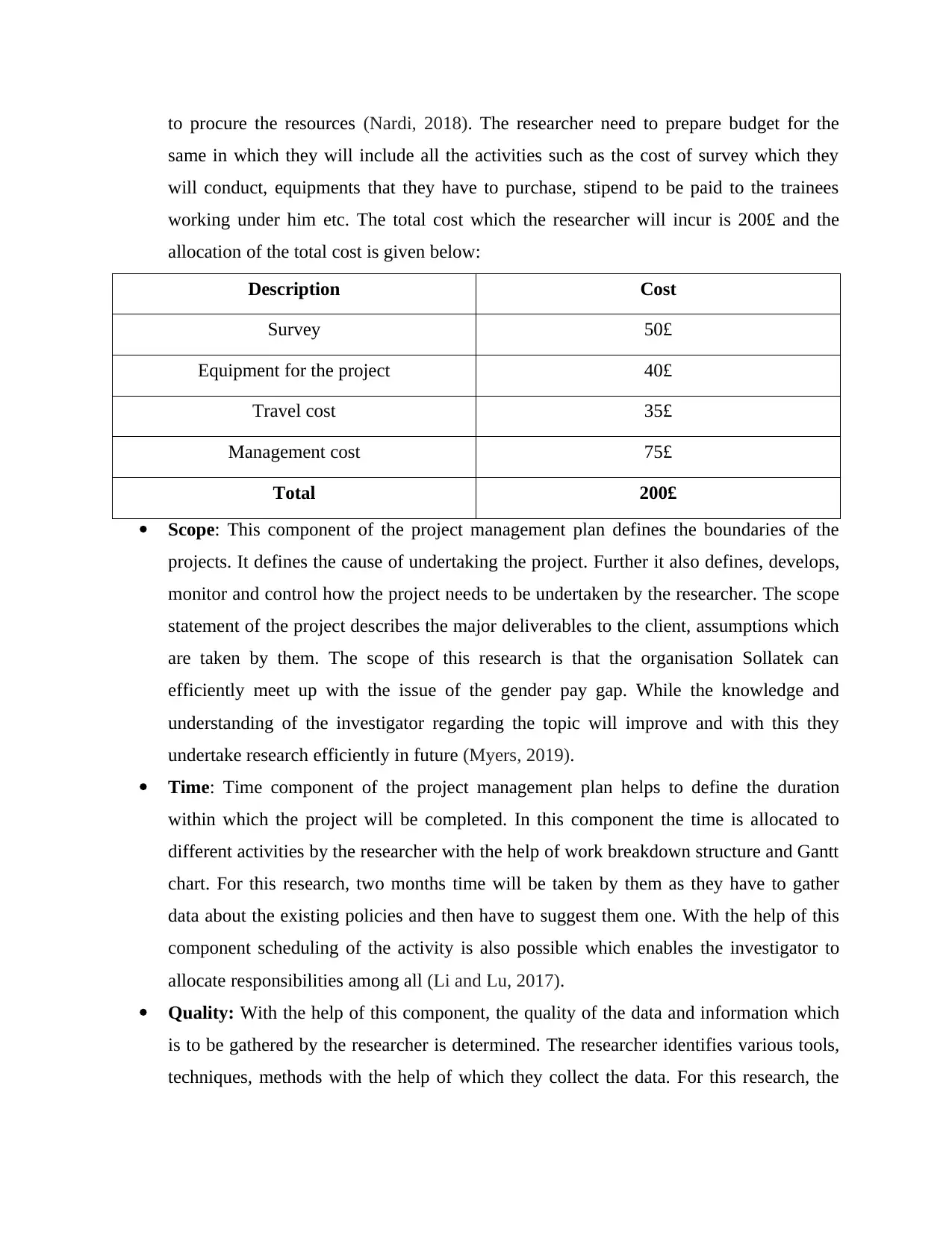
to procure the resources (Nardi, 2018). The researcher need to prepare budget for the
same in which they will include all the activities such as the cost of survey which they
will conduct, equipments that they have to purchase, stipend to be paid to the trainees
working under him etc. The total cost which the researcher will incur is 200£ and the
allocation of the total cost is given below:
Description Cost
Survey 50£
Equipment for the project 40£
Travel cost 35£
Management cost 75£
Total 200£
Scope: This component of the project management plan defines the boundaries of the
projects. It defines the cause of undertaking the project. Further it also defines, develops,
monitor and control how the project needs to be undertaken by the researcher. The scope
statement of the project describes the major deliverables to the client, assumptions which
are taken by them. The scope of this research is that the organisation Sollatek can
efficiently meet up with the issue of the gender pay gap. While the knowledge and
understanding of the investigator regarding the topic will improve and with this they
undertake research efficiently in future (Myers, 2019).
Time: Time component of the project management plan helps to define the duration
within which the project will be completed. In this component the time is allocated to
different activities by the researcher with the help of work breakdown structure and Gantt
chart. For this research, two months time will be taken by them as they have to gather
data about the existing policies and then have to suggest them one. With the help of this
component scheduling of the activity is also possible which enables the investigator to
allocate responsibilities among all (Li and Lu, 2017).
Quality: With the help of this component, the quality of the data and information which
is to be gathered by the researcher is determined. The researcher identifies various tools,
techniques, methods with the help of which they collect the data. For this research, the
same in which they will include all the activities such as the cost of survey which they
will conduct, equipments that they have to purchase, stipend to be paid to the trainees
working under him etc. The total cost which the researcher will incur is 200£ and the
allocation of the total cost is given below:
Description Cost
Survey 50£
Equipment for the project 40£
Travel cost 35£
Management cost 75£
Total 200£
Scope: This component of the project management plan defines the boundaries of the
projects. It defines the cause of undertaking the project. Further it also defines, develops,
monitor and control how the project needs to be undertaken by the researcher. The scope
statement of the project describes the major deliverables to the client, assumptions which
are taken by them. The scope of this research is that the organisation Sollatek can
efficiently meet up with the issue of the gender pay gap. While the knowledge and
understanding of the investigator regarding the topic will improve and with this they
undertake research efficiently in future (Myers, 2019).
Time: Time component of the project management plan helps to define the duration
within which the project will be completed. In this component the time is allocated to
different activities by the researcher with the help of work breakdown structure and Gantt
chart. For this research, two months time will be taken by them as they have to gather
data about the existing policies and then have to suggest them one. With the help of this
component scheduling of the activity is also possible which enables the investigator to
allocate responsibilities among all (Li and Lu, 2017).
Quality: With the help of this component, the quality of the data and information which
is to be gathered by the researcher is determined. The researcher identifies various tools,
techniques, methods with the help of which they collect the data. For this research, the
⊘ This is a preview!⊘
Do you want full access?
Subscribe today to unlock all pages.

Trusted by 1+ million students worldwide
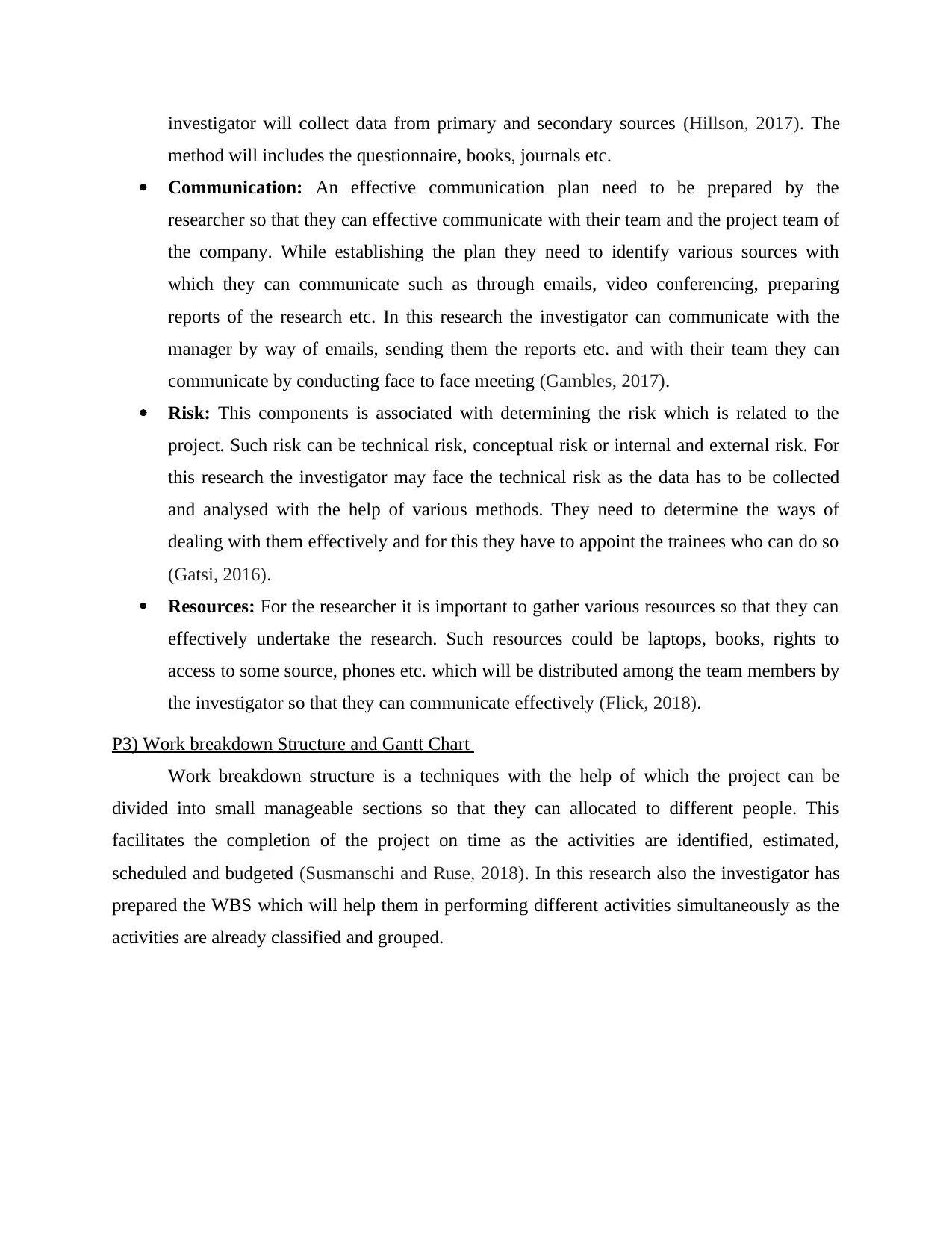
investigator will collect data from primary and secondary sources (Hillson, 2017). The
method will includes the questionnaire, books, journals etc.
Communication: An effective communication plan need to be prepared by the
researcher so that they can effective communicate with their team and the project team of
the company. While establishing the plan they need to identify various sources with
which they can communicate such as through emails, video conferencing, preparing
reports of the research etc. In this research the investigator can communicate with the
manager by way of emails, sending them the reports etc. and with their team they can
communicate by conducting face to face meeting (Gambles, 2017).
Risk: This components is associated with determining the risk which is related to the
project. Such risk can be technical risk, conceptual risk or internal and external risk. For
this research the investigator may face the technical risk as the data has to be collected
and analysed with the help of various methods. They need to determine the ways of
dealing with them effectively and for this they have to appoint the trainees who can do so
(Gatsi, 2016).
Resources: For the researcher it is important to gather various resources so that they can
effectively undertake the research. Such resources could be laptops, books, rights to
access to some source, phones etc. which will be distributed among the team members by
the investigator so that they can communicate effectively (Flick, 2018).
P3) Work breakdown Structure and Gantt Chart
Work breakdown structure is a techniques with the help of which the project can be
divided into small manageable sections so that they can allocated to different people. This
facilitates the completion of the project on time as the activities are identified, estimated,
scheduled and budgeted (Susmanschi and Ruse, 2018). In this research also the investigator has
prepared the WBS which will help them in performing different activities simultaneously as the
activities are already classified and grouped.
method will includes the questionnaire, books, journals etc.
Communication: An effective communication plan need to be prepared by the
researcher so that they can effective communicate with their team and the project team of
the company. While establishing the plan they need to identify various sources with
which they can communicate such as through emails, video conferencing, preparing
reports of the research etc. In this research the investigator can communicate with the
manager by way of emails, sending them the reports etc. and with their team they can
communicate by conducting face to face meeting (Gambles, 2017).
Risk: This components is associated with determining the risk which is related to the
project. Such risk can be technical risk, conceptual risk or internal and external risk. For
this research the investigator may face the technical risk as the data has to be collected
and analysed with the help of various methods. They need to determine the ways of
dealing with them effectively and for this they have to appoint the trainees who can do so
(Gatsi, 2016).
Resources: For the researcher it is important to gather various resources so that they can
effectively undertake the research. Such resources could be laptops, books, rights to
access to some source, phones etc. which will be distributed among the team members by
the investigator so that they can communicate effectively (Flick, 2018).
P3) Work breakdown Structure and Gantt Chart
Work breakdown structure is a techniques with the help of which the project can be
divided into small manageable sections so that they can allocated to different people. This
facilitates the completion of the project on time as the activities are identified, estimated,
scheduled and budgeted (Susmanschi and Ruse, 2018). In this research also the investigator has
prepared the WBS which will help them in performing different activities simultaneously as the
activities are already classified and grouped.
Paraphrase This Document
Need a fresh take? Get an instant paraphrase of this document with our AI Paraphraser
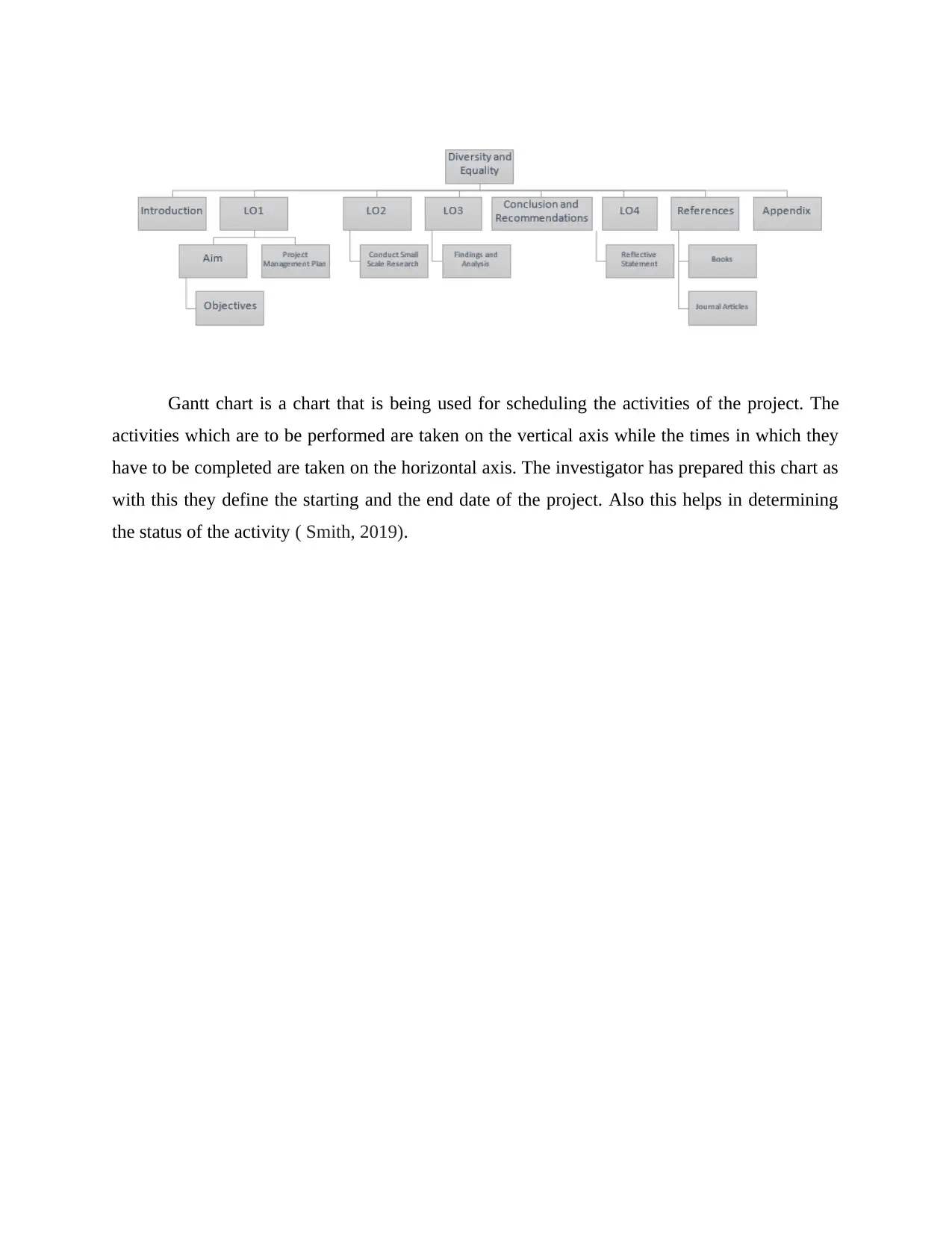
Gantt chart is a chart that is being used for scheduling the activities of the project. The
activities which are to be performed are taken on the vertical axis while the times in which they
have to be completed are taken on the horizontal axis. The investigator has prepared this chart as
with this they define the starting and the end date of the project. Also this helps in determining
the status of the activity ( Smith, 2019).
activities which are to be performed are taken on the vertical axis while the times in which they
have to be completed are taken on the horizontal axis. The investigator has prepared this chart as
with this they define the starting and the end date of the project. Also this helps in determining
the status of the activity ( Smith, 2019).
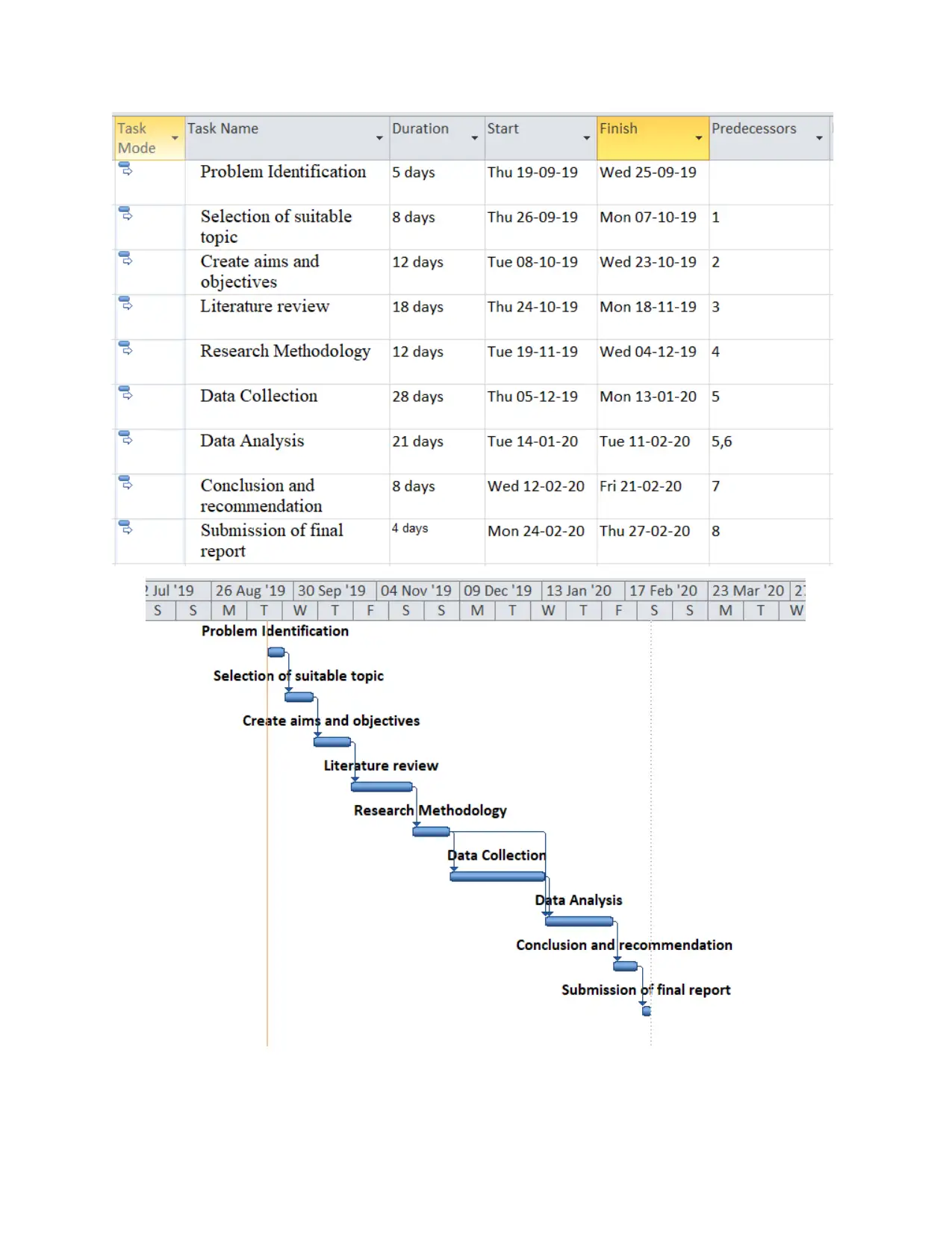
⊘ This is a preview!⊘
Do you want full access?
Subscribe today to unlock all pages.

Trusted by 1+ million students worldwide
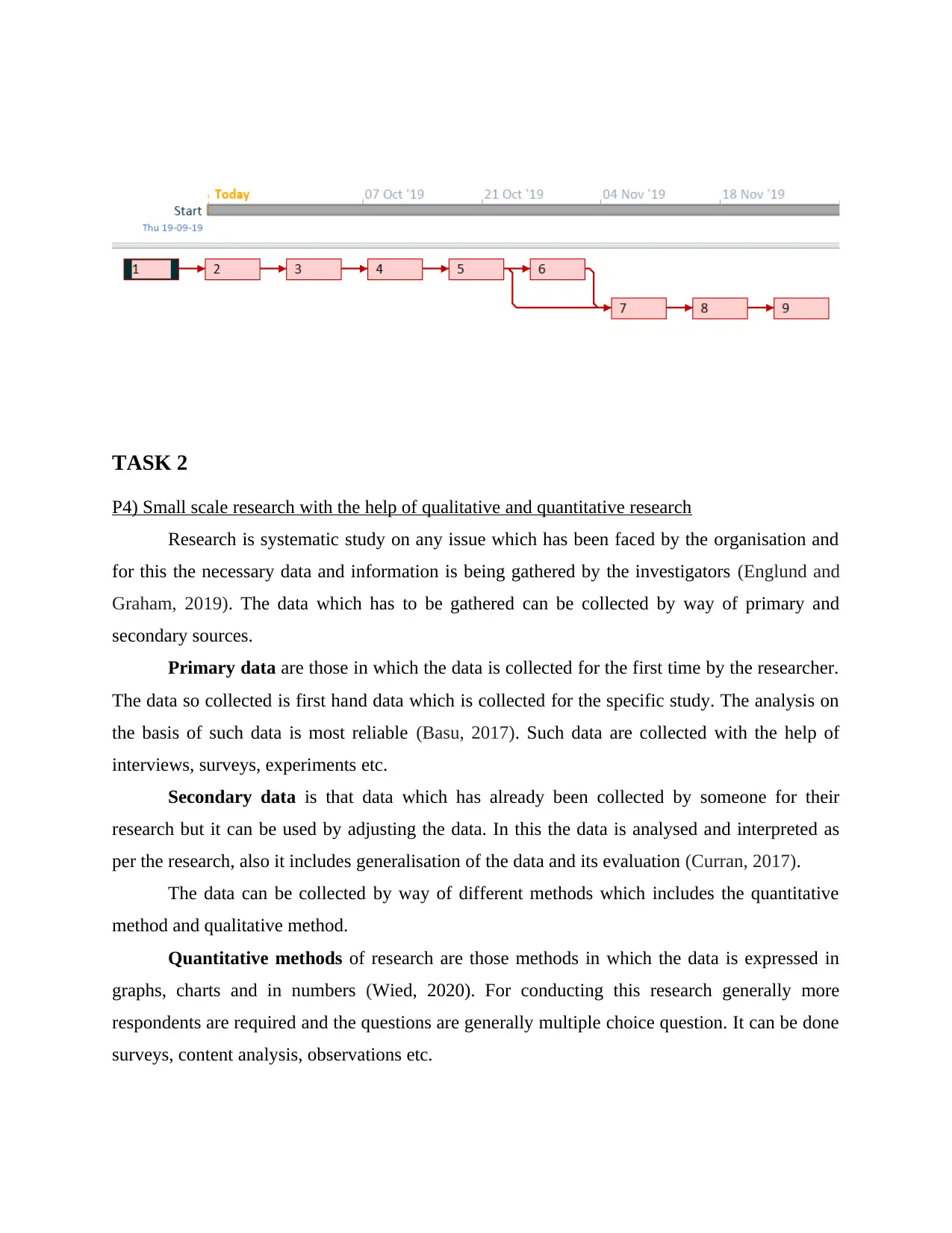
TASK 2
P4) Small scale research with the help of qualitative and quantitative research
Research is systematic study on any issue which has been faced by the organisation and
for this the necessary data and information is being gathered by the investigators (Englund and
Graham, 2019). The data which has to be gathered can be collected by way of primary and
secondary sources.
Primary data are those in which the data is collected for the first time by the researcher.
The data so collected is first hand data which is collected for the specific study. The analysis on
the basis of such data is most reliable (Basu, 2017). Such data are collected with the help of
interviews, surveys, experiments etc.
Secondary data is that data which has already been collected by someone for their
research but it can be used by adjusting the data. In this the data is analysed and interpreted as
per the research, also it includes generalisation of the data and its evaluation (Curran, 2017).
The data can be collected by way of different methods which includes the quantitative
method and qualitative method.
Quantitative methods of research are those methods in which the data is expressed in
graphs, charts and in numbers (Wied, 2020). For conducting this research generally more
respondents are required and the questions are generally multiple choice question. It can be done
surveys, content analysis, observations etc.
P4) Small scale research with the help of qualitative and quantitative research
Research is systematic study on any issue which has been faced by the organisation and
for this the necessary data and information is being gathered by the investigators (Englund and
Graham, 2019). The data which has to be gathered can be collected by way of primary and
secondary sources.
Primary data are those in which the data is collected for the first time by the researcher.
The data so collected is first hand data which is collected for the specific study. The analysis on
the basis of such data is most reliable (Basu, 2017). Such data are collected with the help of
interviews, surveys, experiments etc.
Secondary data is that data which has already been collected by someone for their
research but it can be used by adjusting the data. In this the data is analysed and interpreted as
per the research, also it includes generalisation of the data and its evaluation (Curran, 2017).
The data can be collected by way of different methods which includes the quantitative
method and qualitative method.
Quantitative methods of research are those methods in which the data is expressed in
graphs, charts and in numbers (Wied, 2020). For conducting this research generally more
respondents are required and the questions are generally multiple choice question. It can be done
surveys, content analysis, observations etc.
Paraphrase This Document
Need a fresh take? Get an instant paraphrase of this document with our AI Paraphraser
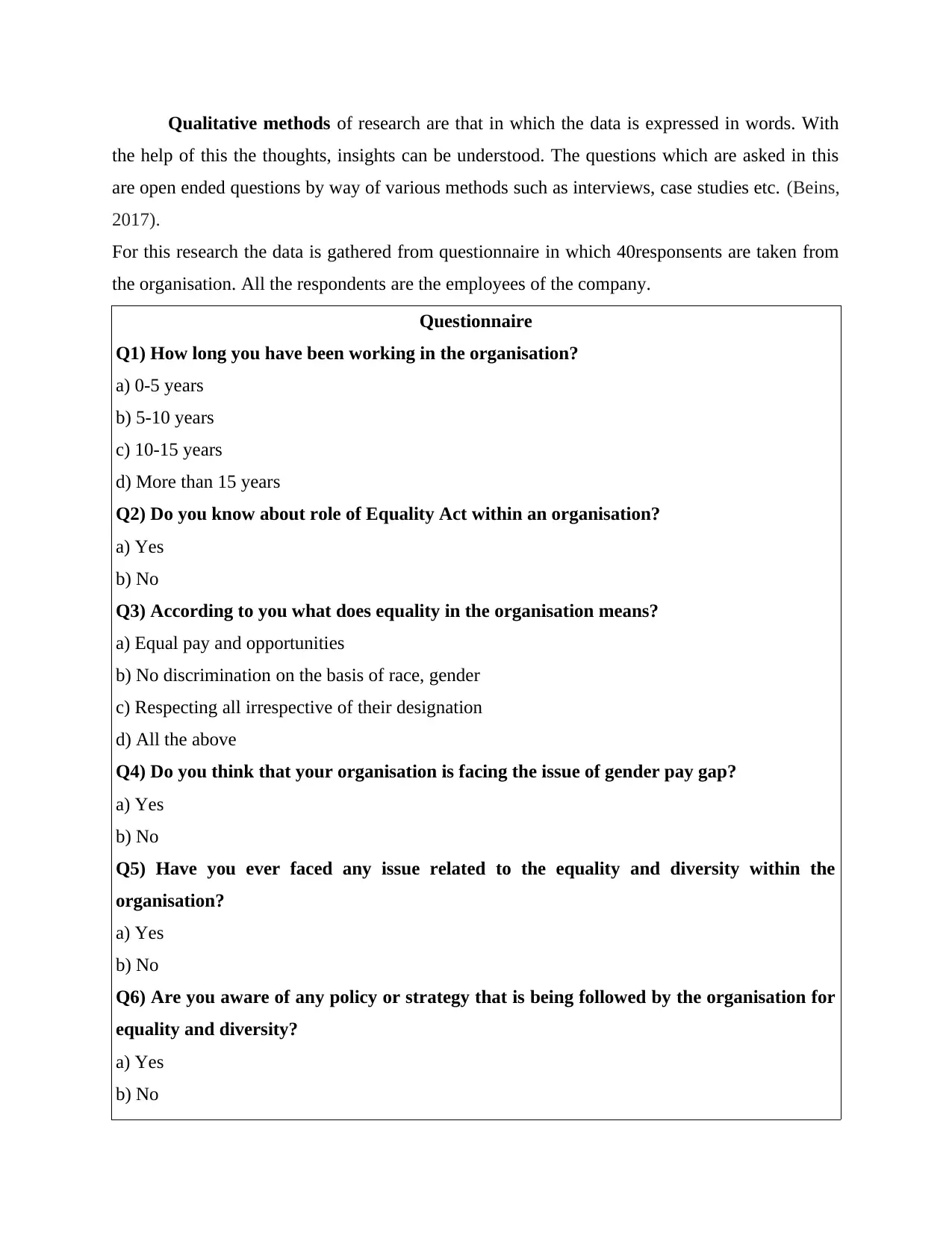
Qualitative methods of research are that in which the data is expressed in words. With
the help of this the thoughts, insights can be understood. The questions which are asked in this
are open ended questions by way of various methods such as interviews, case studies etc. (Beins,
2017).
For this research the data is gathered from questionnaire in which 40responsents are taken from
the organisation. All the respondents are the employees of the company.
Questionnaire
Q1) How long you have been working in the organisation?
a) 0-5 years
b) 5-10 years
c) 10-15 years
d) More than 15 years
Q2) Do you know about role of Equality Act within an organisation?
a) Yes
b) No
Q3) According to you what does equality in the organisation means?
a) Equal pay and opportunities
b) No discrimination on the basis of race, gender
c) Respecting all irrespective of their designation
d) All the above
Q4) Do you think that your organisation is facing the issue of gender pay gap?
a) Yes
b) No
Q5) Have you ever faced any issue related to the equality and diversity within the
organisation?
a) Yes
b) No
Q6) Are you aware of any policy or strategy that is being followed by the organisation for
equality and diversity?
a) Yes
b) No
the help of this the thoughts, insights can be understood. The questions which are asked in this
are open ended questions by way of various methods such as interviews, case studies etc. (Beins,
2017).
For this research the data is gathered from questionnaire in which 40responsents are taken from
the organisation. All the respondents are the employees of the company.
Questionnaire
Q1) How long you have been working in the organisation?
a) 0-5 years
b) 5-10 years
c) 10-15 years
d) More than 15 years
Q2) Do you know about role of Equality Act within an organisation?
a) Yes
b) No
Q3) According to you what does equality in the organisation means?
a) Equal pay and opportunities
b) No discrimination on the basis of race, gender
c) Respecting all irrespective of their designation
d) All the above
Q4) Do you think that your organisation is facing the issue of gender pay gap?
a) Yes
b) No
Q5) Have you ever faced any issue related to the equality and diversity within the
organisation?
a) Yes
b) No
Q6) Are you aware of any policy or strategy that is being followed by the organisation for
equality and diversity?
a) Yes
b) No
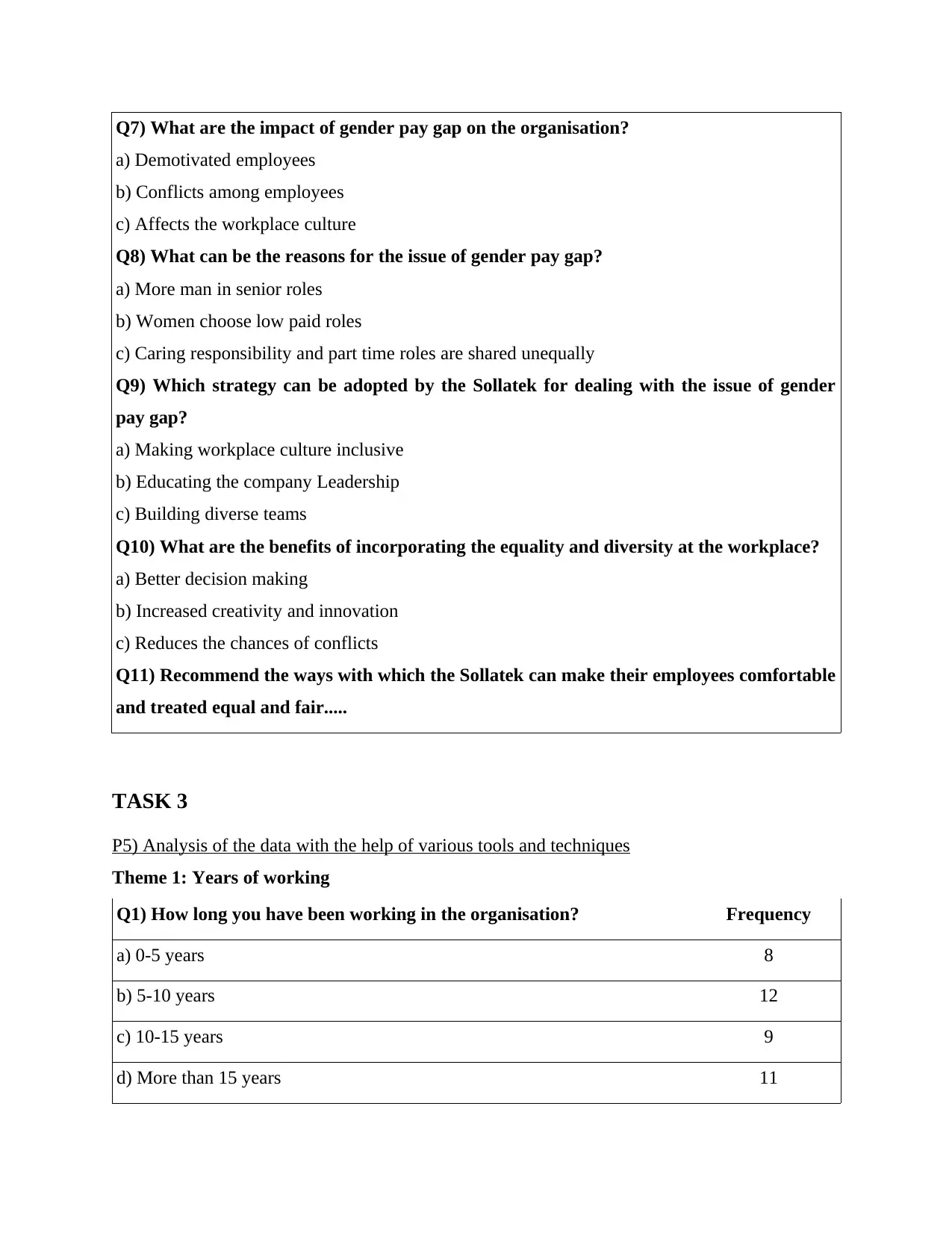
Q7) What are the impact of gender pay gap on the organisation?
a) Demotivated employees
b) Conflicts among employees
c) Affects the workplace culture
Q8) What can be the reasons for the issue of gender pay gap?
a) More man in senior roles
b) Women choose low paid roles
c) Caring responsibility and part time roles are shared unequally
Q9) Which strategy can be adopted by the Sollatek for dealing with the issue of gender
pay gap?
a) Making workplace culture inclusive
b) Educating the company Leadership
c) Building diverse teams
Q10) What are the benefits of incorporating the equality and diversity at the workplace?
a) Better decision making
b) Increased creativity and innovation
c) Reduces the chances of conflicts
Q11) Recommend the ways with which the Sollatek can make their employees comfortable
and treated equal and fair.....
TASK 3
P5) Analysis of the data with the help of various tools and techniques
Theme 1: Years of working
Q1) How long you have been working in the organisation? Frequency
a) 0-5 years 8
b) 5-10 years 12
c) 10-15 years 9
d) More than 15 years 11
a) Demotivated employees
b) Conflicts among employees
c) Affects the workplace culture
Q8) What can be the reasons for the issue of gender pay gap?
a) More man in senior roles
b) Women choose low paid roles
c) Caring responsibility and part time roles are shared unequally
Q9) Which strategy can be adopted by the Sollatek for dealing with the issue of gender
pay gap?
a) Making workplace culture inclusive
b) Educating the company Leadership
c) Building diverse teams
Q10) What are the benefits of incorporating the equality and diversity at the workplace?
a) Better decision making
b) Increased creativity and innovation
c) Reduces the chances of conflicts
Q11) Recommend the ways with which the Sollatek can make their employees comfortable
and treated equal and fair.....
TASK 3
P5) Analysis of the data with the help of various tools and techniques
Theme 1: Years of working
Q1) How long you have been working in the organisation? Frequency
a) 0-5 years 8
b) 5-10 years 12
c) 10-15 years 9
d) More than 15 years 11
⊘ This is a preview!⊘
Do you want full access?
Subscribe today to unlock all pages.

Trusted by 1+ million students worldwide
1 out of 24
Related Documents
Your All-in-One AI-Powered Toolkit for Academic Success.
+13062052269
info@desklib.com
Available 24*7 on WhatsApp / Email
![[object Object]](/_next/static/media/star-bottom.7253800d.svg)
Unlock your academic potential
Copyright © 2020–2025 A2Z Services. All Rights Reserved. Developed and managed by ZUCOL.





